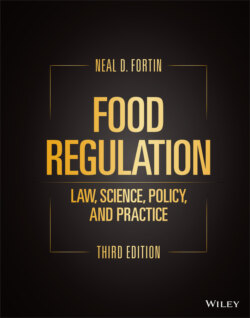Читать книгу Food Regulation - Neal D. Fortin - Страница 117
What’s in a Name? Lean Finely Textured Beef A.K.A. “Pink Slime”
Оглавление“Lean finely textured beef” (LFTB) is the USDA FSIS term for the product made from the fatty scraps left after trimming cuts of meat like steaks and roasts. These trimmings are heated to a low temperature and then spun in a centrifuge to remove most of the fat. The trimmings are then treated with ammonia gas to kill pathogenic bacteria.
Should LFTB be considered “ground beef” for purposes of ingredient labeling? Should it be listed as an ingredient when added to “ground beef”? Those are the issues involved in a controversy over the labeling of LFTB.
Ground beef and hamburger typically are made from trimmings left after the larger cuts of meat are removed, so in that sense LFTB is like ground beef. The difference with LFTB is that it takes advantage of lower value scraps, those meat trimmings with such small amounts of meat that cutting off the excess fat by hand is not worthwhile. In the past, these trimmings had been removed and diverted for lower value uses, such as in animal feed and cooking oil. Thus, LFTB provides a less expensive source of lean beef protein. Although LFTB has a high protein content that enabled ground beef producers to reduce the fat percentage in their product, the nutritional content of the trimmings used to make LFTB is not the same as muscle meat. LFTB contains more serum and connective tissue proteins and less muscle proteins.24
Initially, LFTB was regulated by the USDA as a category of beef products derived from beef trimmings known as “partially defatted chopped beef” (PDCB). Although PDCB is from beef, it is not “beef” as in “ground beef.” PDCB can be added to other food products, such as “beef patty mix,” but PDCB generally must be specifically listed in the ingredient statement.25 Many things come from beef, but only select parts of the beef are considered “beef” for addition to “ground beef” and “hamburger.”
Title 9 of the Code of Federal Regulations, section 319.15 states in part:
“Partially Defatted Beef Fatty Tissue” is a beef byproduct derived from the low temperature rendering (not exceeding 120 °F.) of fresh beef fatty tissue. Such product shall have a pinkish color and a fresh odor and appearance.
While LFTB is similar to other PDCB, it has protein content closer to hand‐trimmed beef. Using this information, Beef Products, Inc. (BPI), the primary producer of LFTB, requested this product be reclassified as “fat reduced beef,” and after five years of review and study, USDA approved the request in 1991, and the product could be labeled as “lean finely textured beef (LFTB).” Two years later, USDA granted BPI permission to include LFTB in ground beef. USDA also made a determination that for ingredient labeling purposes, LFTB was “beef”; therefore, USDA did not require LFTB be labeled as a separate ingredient in ground beef.26
Title 9 of the Code of Federal Regulations, section 319.15 states in part:
“Ground beef” … shall consist of chopped fresh and/or frozen beef with or without seasoning and without the addition of beef fat as such, shall not contain more than 30 percent fat, and shall not contain added water, phosphates, binders, or extenders.
To consider LFTB as “beef” for labeling purposes, USDA had to interpret the language “fresh and/or frozen beef” as appropriately describing LFTB. The determination that LFTB was “fresh beef” arguably was inconsistent with the agency’s determination on other ingredients, such as PDCB. While LFTB is “beef” in the broad sense that any part of a bovine animal is beef, it is a stretch to call LFTB “beef” within the traditional meaning of that term within meat standards. In that context, not all parts of a bovine are considered “beef.” For example, the USDA FSIS Food Standards and Labeling Policy Book states in part the following regarding “ground beef ”:
Cheek meat is permitted up to 25 percent and must be declared in the ingredients statement. For more than 25 percent, show as—“Ground Beef and Cheek Meat”, all the same size. Beef of skeletal origin, or from the diaphragm or esophagus (weasand) may be used in the preparation of chopped beef, ground beef, or hamburger. Heart meat and tongue meat as organ meats are not acceptable ingredients in chopped beef, ground beef, or hamburger.27
The presence of LFTB was revealed to the public by the news media, which dubbed LFTB, “pink slime.”28 The term was quickly picked up by the public, and sales of LFTB plummeted. BPI, the major manufacturer of LFTB, lost 80 percent of its sales in twenty‐eight days and closed three of its four manufacturing plants.29 Since then LFTB has slowly returned to the marketplace.30
